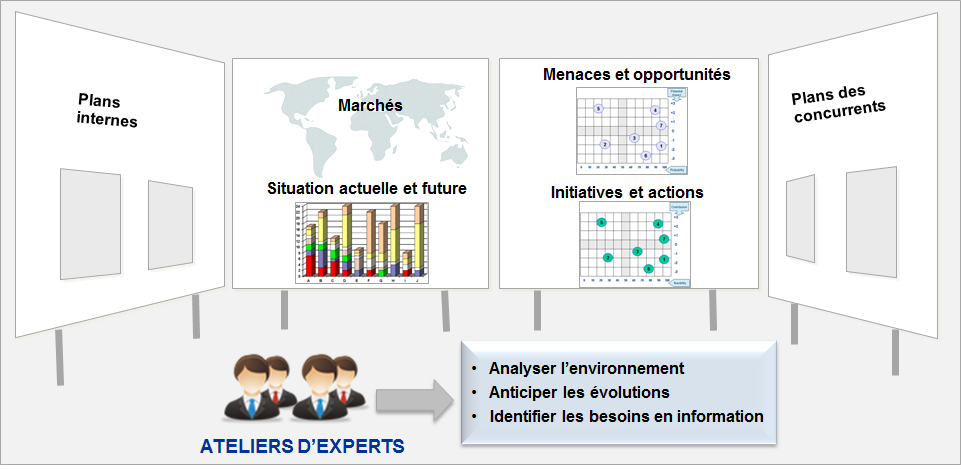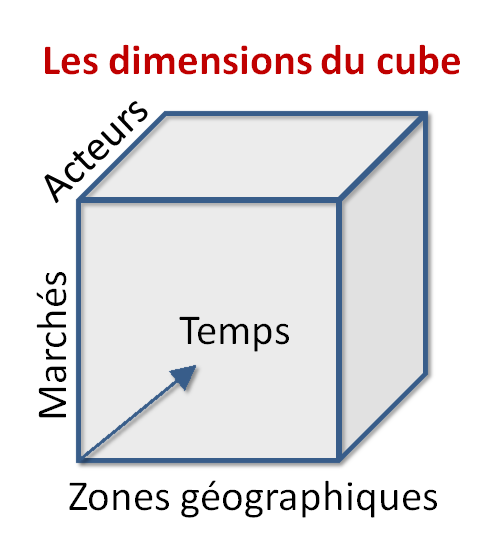Business War Games are collective analysis workshops designed to build and adapt corporate strategy, based on role-playing, real data and scenarios. These “games” involve anticipating market trends and movements of key players by consolidating information, simulating scenarios and assessing their impact on the company.
By building a shared vision of the issues at stake, these workshops both reinforce action plans and facilitate their operational implementation. By interconnecting knowledge and organizational silos, the company gains in knowledge, agility and efficiency. It’s also a creative team-building exercise that reinforces the company’s leadership culture.
DECOUVREZ DANS CET ARTICLE
- What is a war room?
- What can a War Game do for your teams?
- When should a War Game be used?
- What process should you put in place?
- A place for sharing and internal dialogue
- Who manages the project?
- Who takes part in the war games?
- Which sources of information to tap?
- An interactive decision-making dashboard
- A company management tool
- Read more
What is a war room?
“Lost battles can be summed up in two words: too late “, recalled General Douglas MacArthur, almost 2,500 years after Sun Tzu, the great Chinese general of the Warring Kingdoms. War Rooms were created to develop an army’s capacity for anticipation and adaptation.
A War Room was originally a center for coordinating military action. The best-known is undoubtedly Winston Churchill’s secret underground headquarters in London, the British nerve center during the Second World War.
Among the main rooms in these “Cabinet War Rooms” are the Map Room, the planning center, the Cabinet Room, used for meetings of British decision-makers, Churchill’s Room, where he slept when he couldn’t get back to 10 Downing Street, and finally the Transatlantic Telephone Room, where Churchill spoke with the American President using a secure telephone line.
The concept then evolved and was adapted to the context of political decision-makers and corporate executives. The evolution of technology has also enabled us to reduce costs, increase efficiency and make this type of system accessible to smaller organizations. The term “warrior” has been retained, however, as a general management War Room is inspired by similar methods.
A War Room is generally located in one of several meeting rooms, connected to an information system and equipped with several screens displaying targeted information on the walls of the room. Individual screens can be integrated into the meeting table. Cameras can even record work sessions, broadcast them to conference rooms, and save information written or drawn on whiteboards. This operational center is first and foremost a space for analysis and decision-making.
By extension, the War Room concept can encompass both the operations center itself and the market analysis and simulation process: the War Games.


What can a War Game do for your teams?
Beyond the physical space of a War Room and the information system, the value of setting up a War Game depends on the results delivered at the end of the analysis workshops, and on the personal appreciation of the end-customers, which can be rapidly assessed at the end of the project.
For managers: The most anticipated benefit is the acceleration of the decision-making process by providing better, faster, more effective information. The true return on investment is measured in terms of markets won, takeover bids won, technology gaps closed and mergers & acquisitions successfully completed.
For project teams: By providing a resource of both summary and detailed information on the environment, a War Room improves the efficiency of meetings and accelerates internal projects. It helps structure the decision-making information system and capitalize on operational knowledge for the company’s teams.
For corporate culture: It’s an opportunity for participants to get to know each other better, work together and share a common vision of issues and priorities. This strengthens team cohesion, stimulates strategic thinking and reinforces the company’s leadership culture.
For the business intelligence team: One of the expected results is the identification and prioritization of Key Intelligence Topics and blind spots. This work forms the basis of a plan for information gathering and environmental monitoring.
When should a War Game be used?
A War Game is an effective tool for reducing uncertainty in a complex situation and making resource-intensive decisions more reliable. It enables us to understand and monitor a multi-dimensional environment, and to anticipate the movements of the players influencing the market. And the results can be decisive for certain business operations:
- Launching a new product
- An acquisition project
- Winning a tender
- Commercial penetration of a territory
- Managing a media crisis
For example, if the company is planning to launch a new product on the market, the project will consolidate all current and future market information, simulate potential competitor movements and assess the consequences for other market players. The aim is to provide decision-makers with an informed view of the opportunities and threats facing the company.
In certain situations, the company seeks to mobilize its teams and build a shared internal vision of the situation before drawing up an action plan or corporate strategy, which the participants will then have to implement to achieve the defined objectives.
In this case, the outcome of the War Room depends essentially on the quality of the information shared and the results of the analysis workshops. This implies setting up an information system consolidating a multitude of independent sources, with appropriate processing and analysis capacity. On the other hand, expert workshops help accelerate knowledge production and build consensus within the company.
In a dynamic mode, analysis and simulation workshops, or War Games, aim to validate and refine a previously defined strategy by simulating its execution, anticipating obstacles and the reactions of market players. In this case, role-playing plays an essential role.
By concentrating resources – information, expertise, budget – on a single objective, that of the War Room , the company naturally increases its chances of success. All that remains is to know what system to put in place to achieve the company’s objective.
What process should you put in place?
After validating the information needs of management and formalizing the main orientations of the project, information gathering becomes the key stage in the process. A research team is then tasked with identifying accessible sources of information and providing useful documentation for participants.


War Games, or analysis workshops, are then conducted over one or more days, to collectively develop answers to the questions posed, taking into account the multiple sources and different dimensions of the problem, for example :
- Customers / Market : Who are the key customers, what are their needs and constraints, what are the decision-making processes, what are the trends?
- Competition: Who are the direct and indirect competitors, what are their current positions and resources, their priorities and intentions?
- Economy: what are the key indicators impacting the market (market drivers), what are the most likely trends and events?
- Technologies: what innovations are impacting existing processes and “territories”?
Several environmental analysis models can be used, of which the best known are :
- SWOT matrices, which focus analysis on strengths and weaknesses, threats and opportunities
- Michaël Porter’s model focuses on the analysis of competitive forces and industry players,
- The PESTEL analysis model (Political, Economic, Social, Technological, Environmental, Legal), integrates the macro-environmental factors influencing the market, and so on.
- Risk analysis matrices, which enable threats to be ranked according to their impact and probability.
- Game theory models can provide advanced methodological support for the project, depending on the needs and culture of the managers.
A place for sharing and internal dialogue
The points of divergence between workshop participants mark the limits of consensus. They are identified in the form of questions and documented by the team’s “watchdog”. They represent intelligence gaps. Additional information may then be requested to confirm or adjust the collective assessment.
When a company is considering investing in a new production unit, it is often more comfortable for decision-makers to launch an information gathering operation to validate a scenario and thus ensure strategic choices before committing the company in the long term.
During War Games, participants can replay the same sequences several times, taking into account the actions of other teams. This enables each team to refine its tactics, integrate the complexity of their environment, and anticipate the movements of market players: competitors, distributors, suppliers, regulatory authorities, prescribers, and so on.
A War Game is first and foremost a moment of exchange aimed at answering questions, which implies providing a sufficient level of information to provide a reliable answer and generate new questions. As with intelligence operations, time is a key factor in success. It is therefore generally preferable to run a War Room over several days, or even months. In this way, knowledge can be built up gradually, without haste, and then refined over time.
Who manages the project?
A core team is set up to manage the project and achieve the set objective.
- A sponsor: The financer and main customer, this is often the executive or a member of the management committee. It determines the company’s direction, formulates its expectations and sets key deadlines.
- An in-house project manager: as project coordinator, he/she ensures that the project is properly implemented, organizes the analysis workshops and delivers the results to the War Room.
- Team leaders: they are appointed to lead a cross-functional team and are responsible for the team’s contribution during analysis workshops.
- A consultant facilitator: A War Room specialist, he provides technical, organizational and methodological support to ensure the project manager’s success.
- An information research team: Information professionals responsible for researching documents, consolidating data, providing summaries and feeding dashboards. They provide information support for contributors and the project team.
Who takes part in the war games?
To carry out assessments and simulations, several teams come together in a series of collaborative workshops. Each team represents, for example, a competitor, a group of market players, a product range or a territory. It is responsible for assessing the situation from different angles, simulating scenarios and making recommendations.
A team is generally made up of 4 to 8 people and has its own organization. For example:
- A leader who ensures that time limits are respected and that group dynamics are maintained
- A Secretary to capture and formalize group assessments
- A Watchman to identify issues and differences of opinion
- A Presenter responsible for communicating his team’s results to the other participants
- A Facilitator to guide teams and answer methodological questions
Participants are chosen for their knowledge of the environment studied, their experience and their position in the company. The teams are made up of diverse personalities from different departments (Marketing, R&D, Production, etc.), each bringing their own experience, information, culture and world view.
The number of teams depends on the needs of the project and the interplay between the teams. Their composition must be balanced and multi-disciplinary to ensure the most comprehensive and objective assessment possible.
A constructive and harmonious atmosphere within a team is a source of creativity, so it’s best to avoid one person taking the upper hand over the group, through too great a hierarchical gap, an overpowering personality or an expert who always has the last word.
It’s also a good idea to build up knowledge in stages, starting with detailed contributions from business experts, then comparing results with managers, gradually raising the hierarchical levels of contributors.
Which sources of information to tap?
In preparation for the collaborative workshops, the research team identifies all accessible sources of information and gathers all documentation useful to the participants. Indeed, the more quality information is available, the less uncertainty there is, and the more reliable the results of analysis workshops are. As the definition of the scope (countries, competitors, markets, etc.) is a cost and complexity variable, it is validated at the design stage.
The company’s monitoring system is an insufficient but essential source of information for the system. Its function is to constantly monitor the environment and organize useful information (by category, date, source…). In this way, qualitative information derived from monitoring can be combined with other data and integrated into a Business Intelligence solution.
All internal and external sources need to be exploited: market studies, sales databases, internal reports and documents, etc. In-house experts are also important sources of privileged information. Above all, they contribute their knowledge of the business and their personal viewpoints.
The War Game must centralize both factual information and data, as well as expert assessments, comments and projections. The workshops should highlight areas of uncertainty, and in particular “black holes” where no information is available on a key subject (intelligence gaps). That’s why a War Game is also an opportunity to set up a more structured intelligence system, and trigger a dynamic of corporate intelligence.
An interactive decision-making dashboard
The information system on which the War Game is based is a central tool in the system. It must consolidate information sources of all kinds (data, documents, images, articles, comments, etc.), share knowledge within communities, visualize results and produce summaries.
An eWar Room is a Business Intelligence solution adapted to the specific requirements of a War Room, i.e. collaborative evaluation and simulation. Business Intelligence and datamining solutions can be used to measure and represent several indicators: for example, sales (data from the internal information system), external qualitative information (data from the intelligence system) and the most likely scenarios (data from the War Games).


By combining different views, you can analyze a set of data from different angles within the same “cube”:
1) Time axis : by year, by quarter, by month, by day
2) Product/market axis: product family, product range, product reference
3) Geographic: by country or group of countries, by region, by location
4) Stakeholder axis : by competitor, customer, distributor, supplier, other stakeholders
Data visualization is favored because it facilitates the human processing of a large amount of data: dashboards, graphs, maps, color codes and symbols make it possible to “digest” information and integrate several parameters into the analysis.
To visualize information, dynamic mapping tools provide geographic, temporal or relational views. There are a multitude of software products covering a wide range of application fields, with widely varying price differentials. It’s therefore important to assess internal needs carefully, in order to provide the right technical solution in line with objectives, budget and, above all, users’ real expectations.
The multiplication of screens in the operations room makes it possible to represent the same situation from different angles (country, market, competitor…) and on several levels (global and detailed). Aggregated views offer a synthetic view of results, with operations performed by subset: sum, average, minimum/maximum, etc.
Indicators are selected according to their impact on the company: measurements of inventories, flows, growth rates, market shares, scores, relations between entities, etc. The format for reporting indicators and information is defined at the very start of the War Room project, as the reports must be adapted to the managers’ reading grid, their culture and their concerns. The frequency of data updates (real-time, daily, quarterly) is also an element to be evaluated, as it can be a significant cost variable for the War Room.
The value of dashboards lies above all in the quality of their production process. An indicator is only relevant if the user knows its definition and scope, unit of measurement, data source and publication date. In this way, the traceability of information and the assessment of its reliability determine the quality of the analysis, which in turn can have an impact on the decision-making process.
A company management tool
In conclusion, the return on investment of a War Game is quickly perceived by managers. Beyond the direct results it brings to the decision-making process, it’s an effective way of structuring the information system, while stimulating imagination and creativity, and strengthening team cohesion and the company’s leadership culture. Much more than just a hardware tool, a War Game is a genuine management tool that mobilizes and channels energies into a battle that must be won.
Read more
Since 2007, HUMIND has conducted a number of war games to reinforce the operational plan for a product launch, to address competitive issues, to prepare a tactical or strategic plan, or to support an acquisition/partnership project.
Do you have a project in mind? A question? Contact us to find out more.


